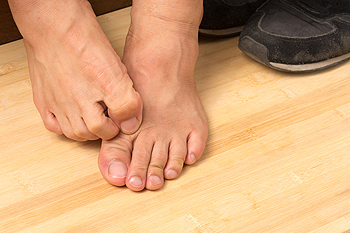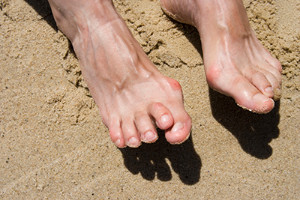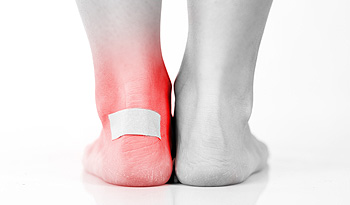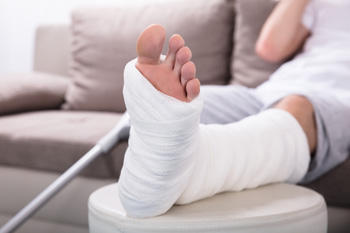October 2020
Is My Ankle Broken, or Sprained?
It can be difficult to tell the difference between an ankle that is broken and an ankle that is sprained. A break occurs when one or more of the three bones in the ankle joint, the tibia, fibula, or talus, is fractured. A sprain occurs when the ligaments that join the bones of the ankle are overstretched or torn. Both conditions may cause pain, swelling, bruising, and an inability to put weight on the affected ankle. If you have mild to moderate pain but can still put some weight on the ankle after an injury, then it is most likely a sprain. However, if you have pain that is severe or gets worse over time, can’t put weight on the injured ankle, have trouble moving the ankle, hear a popping noise at the time of injury, or notice that your ankle looks misaligned or deformed, then it is most likely a break. In any case, it is best to visit a podiatrist for a proper diagnosis and treatment plan.
Broken ankles need immediate treatment. If you are seeking treatment, contact Dr. Lee R. Stein from Lake Shore Foot & Ankle, PC. Our doctor can provide the care you need to keep you pain-free and on your feet.
Broken Ankles
A broken ankle is experienced when a person fractures their tibia or fibula in the lower leg and ankle area. Both of these bones are attached at the bottom of the leg and combine to form what we know to be our ankle.
When a physician is referring to a break of the ankle, he or she is usually referring to a break in the area where the tibia and fibula are joined to create our ankle joint. Ankles are more prone to fractures because the ankle is an area that suffers a lot of pressure and stress. There are some obvious signs when a person experiences a fractured ankle, and the following symptoms may be present.
Symptoms of a Fractured Ankle
- Excessive pain when the area is touched or when any pressure is placed on the ankle
- Swelling around the area
- Bruising of the area
- Area appears to be deformed
If you suspect an ankle fracture, it is recommended to seek treatment as soon as possible. The sooner you have your podiatrist diagnose the fracture, the quicker you’ll be on the way towards recovery.
If you have any questions, please feel free to contact one of our offices located in Chicago, Highland Park, and Uptown, IL . We offer the newest diagnostic and treatment technologies for all your foot care needs.
What Should I Do if I Have Athlete's Foot?
 Tinea pedis, or Athlete’s foot as it is more commonly known, is a fungal infection of the skin and feet. It typically affects the spaces between the toes and is characterized by cracked, scaly skin. This infection is contagious and can be spread through contact with infected skin flakes or through contact with fungi in damp areas, such as public swimming pools. If you find yourself with athlete’s foot, it is important to keep the feet clean, dry, and cool, as the fungus thrives and multiplies in warm, moist environments. You should also avoid public swimming pools, public showers, and foot baths. Wear sandals if possible, or air out your shoes by alternating them every 2-3 days. Avoid wearing socks made from fabrics like nylon, which do not dry easily. Finally, follow your doctor’s prescribed treatments, which can include topical or oral antifungal medications. If you think that you may have athlete’s foot, it is suggested that you seek the care of a podiatrist.
Tinea pedis, or Athlete’s foot as it is more commonly known, is a fungal infection of the skin and feet. It typically affects the spaces between the toes and is characterized by cracked, scaly skin. This infection is contagious and can be spread through contact with infected skin flakes or through contact with fungi in damp areas, such as public swimming pools. If you find yourself with athlete’s foot, it is important to keep the feet clean, dry, and cool, as the fungus thrives and multiplies in warm, moist environments. You should also avoid public swimming pools, public showers, and foot baths. Wear sandals if possible, or air out your shoes by alternating them every 2-3 days. Avoid wearing socks made from fabrics like nylon, which do not dry easily. Finally, follow your doctor’s prescribed treatments, which can include topical or oral antifungal medications. If you think that you may have athlete’s foot, it is suggested that you seek the care of a podiatrist.
Athlete’s foot is an inconvenient condition that can be easily reduced with the proper treatment. If you have any concerns about your feet and ankles, contact Dr. Lee R. Stein from Lake Shore Foot & Ankle, PC. Our doctor will treat your foot and ankle needs.
Athlete’s Foot: The Sole Story
Athlete's foot, also known as tinea pedis, can be an extremely contagious foot infection. It is commonly contracted in public changing areas and bathrooms, dormitory style living quarters, around locker rooms and public swimming pools, or anywhere your feet often come into contact with other people.
Solutions to Combat Athlete’s Foot
- Hydrate your feet by using lotion
- Exfoliate
- Buff off nails
- Use of anti-fungal products
- Examine your feet and visit your doctor if any suspicious blisters or cuts develop
Athlete’s foot can cause many irritating symptoms such as dry and flaking skin, itching, and redness. Some more severe symptoms can include bleeding and cracked skin, intense itching and burning, and even pain when walking. In the worst cases, Athlete’s foot can cause blistering as well. Speak to your podiatrist for a better understanding of the different causes of Athlete’s foot, as well as help in determining which treatment options are best for you.
If you have any questions please feel free to contact one of our offices located in Chicago, Highland Park, and Uptown, IL . We offer the newest diagnostic and treatment technologies for all your foot and ankle needs.
Why Live with Pain and Numbness in Your Feet?
Ways to Prevent Hammertoe
Hammerto e is a deformity of the toes that causes the small toes to bend at the joint. If left untreated, hammertoes can be permanent. Common signs of hammertoe include curling toes, thickening of the skin on the affected toe, trouble finding shoes that fit correctly, and pain. One of the leading causes of hammertoe is poor fitting shoes. Avoid shoes that have a narrow and pointed toe, that are too tight, or that have a high heel. Shoes that have wide toe boxes and are roughly a half inch longer than your longest toe are generally best to reduce the risk of hammertoe. A proper diagnosis and treatment plan for hammertoe will require visiting a podiatrist, so if you believe that you are suffering from hammertoe, consult with a podiatrist as soon as possible.
e is a deformity of the toes that causes the small toes to bend at the joint. If left untreated, hammertoes can be permanent. Common signs of hammertoe include curling toes, thickening of the skin on the affected toe, trouble finding shoes that fit correctly, and pain. One of the leading causes of hammertoe is poor fitting shoes. Avoid shoes that have a narrow and pointed toe, that are too tight, or that have a high heel. Shoes that have wide toe boxes and are roughly a half inch longer than your longest toe are generally best to reduce the risk of hammertoe. A proper diagnosis and treatment plan for hammertoe will require visiting a podiatrist, so if you believe that you are suffering from hammertoe, consult with a podiatrist as soon as possible.
Hammertoes can be a painful condition to live with. For more information, contact Dr. Lee R. Stein of Lake Shore Foot & Ankle, PC. Our doctor will answer any of your foot- and ankle-related questions.
Hammertoe
Hammertoe is a foot deformity that occurs due to an imbalance in the muscles, tendons, or ligaments that normally hold the toe straight. It can be caused by the type of shoes you wear, your foot structure, trauma, and certain disease processes.
Symptoms
- Painful and/or difficult toe movement
- Swelling
- Joint stiffness
- Calluses/Corns
- Physical deformity
Risk Factors
- Age – The risk of hammertoe increases with age
- Sex – Women are more likely to have hammertoe compared to men
- Toe Length – You are more likely to develop hammertoe if your second toe is longer than your big toe
- Certain Diseases – Arthritis and diabetes may make you more likely to develop hammertoe
Treatment
If you have hammertoe, you should change into a more comfortable shoe that provides enough room for your toes. Exercises such as picking up marbles may strengthen and stretch your toe muscles. Nevertheless, it is important to seek assistance from a podiatrist in order to determine the severity of your hammertoe and see which treatment option will work best for you.
If you have any questions, please feel free to contact one of our offices located in Chicago, Highland Park, and Uptown, IL . We offer the newest diagnostic and treatment technologies for all your foot care needs.
The Definition of a Blister
 Blisters on the feet can typically develop from friction. This can occur as a result of wearing shoes that do not fit correctly, or from excessive walking and hiking. A blister is defined as a small pocket of fluid that forms to protect the damaged skin. When the skin has repaired itself, the blister will gradually drain. Some patients find it helpful to put powder or cornstarch inside their shoes and socks, which may absorb excess moisture. If a blister on your foot has developed, it is important that you give it immediate attention to protect it, as this can be beneficial in preventing an infection from occurring. This can be accomplished by covering it with a bandage until it has drained naturally. If you get blisters on your feet, It is suggested that you confer with a podiatrist, who can guide you toward prevention strategies.
Blisters on the feet can typically develop from friction. This can occur as a result of wearing shoes that do not fit correctly, or from excessive walking and hiking. A blister is defined as a small pocket of fluid that forms to protect the damaged skin. When the skin has repaired itself, the blister will gradually drain. Some patients find it helpful to put powder or cornstarch inside their shoes and socks, which may absorb excess moisture. If a blister on your foot has developed, it is important that you give it immediate attention to protect it, as this can be beneficial in preventing an infection from occurring. This can be accomplished by covering it with a bandage until it has drained naturally. If you get blisters on your feet, It is suggested that you confer with a podiatrist, who can guide you toward prevention strategies.
Blisters are prone to making everyday activities extremely uncomfortable. If your feet are hurting, contact Dr. Lee R. Stein of Lake Shore Foot & Ankle, PC. Our doctor can provide the care you need to keep you pain-free and on your feet.
Foot Blisters
Foot blisters develop as a result of constantly wearing tight or ill-fitting footwear. This happens due to the constant rubbing from the shoe, which can often lead to pain.
What Are Foot Blisters?
A foot blister is a small fluid-filled pocket that forms on the upper-most layer of the skin. Blisters are filled with clear fluid and can lead to blood drainage or pus if the area becomes infected.
How Do Blisters Form?
Blisters on the feet are often the result of constant friction of skin and material, usually by shoe rubbing. Walking in sandals, boots, or shoes that don’t fit properly for long periods of time can result in a blister. Having consistent foot moisture and humidity can easily lead to blister formation.
Prevention & Treatment
It is important to properly care for the affected area in order to prevent infection and ease the pain. Do not lance the blister and use a Band-Aid to provide pain relief. Also, be sure to keep your feet dry and wear proper fitting shoes. If you see blood or pus in a blister, seek assistance from a podiatrist.
If you have any questions, please feel free to contact one of our offices located in Chicago, Highland Park, and Uptown, IL . We offer the newest diagnostic and treatment technologies for all your foot care needs.
Blog Archives
- April 2025
- March 2025
- February 2025
- January 2025
- December 2024
- November 2024
- October 2024
- September 2024
- August 2024
- July 2024
- June 2024
- May 2024
- April 2024
- March 2024
- February 2024
- January 2024
- December 2023
- November 2023
- October 2023
- September 2023
- August 2023
- July 2023
- June 2023
- May 2023
- April 2023
- March 2023
- February 2023
- January 2023
- December 2022
- November 2022
- October 2022
- September 2022
- August 2022
- July 2022
- June 2022
- May 2022
- April 2022
- March 2022
- February 2022
- January 2022
- December 2021
- November 2021
- October 2021
- September 2021
- August 2021
- July 2021
- June 2021
- May 2021
- April 2021
- March 2021
- February 2021
- January 2021
- December 2020
- November 2020
- October 2020
- September 2020
- August 2020
- July 2020
- June 2020
- May 2020
- April 2020
- March 2020
- February 2020
- January 2020
- December 2019
- November 2019
- October 2019
- September 2019
- August 2019
- July 2019
- June 2019
- May 2019
- April 2019
- March 2019
- February 2019
- January 2019
- December 2018
- November 2018
- October 2018
- September 2018
- August 2018
- July 2018









